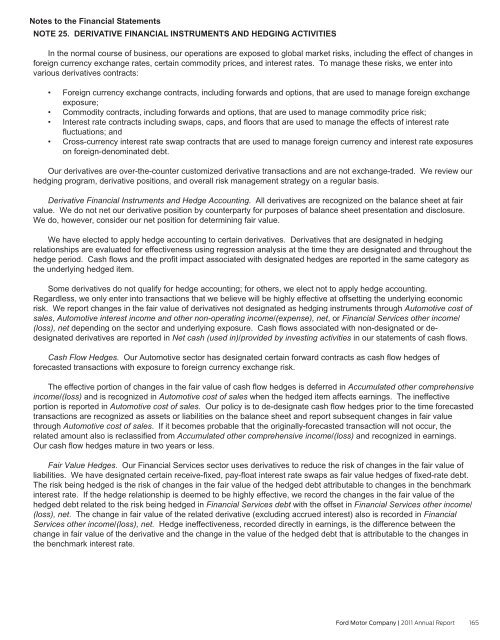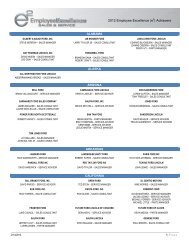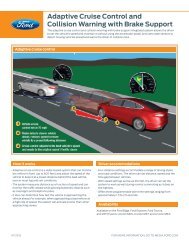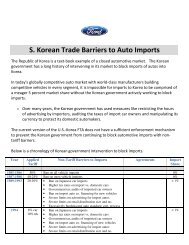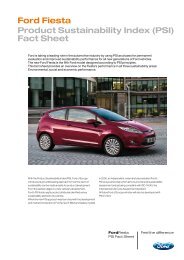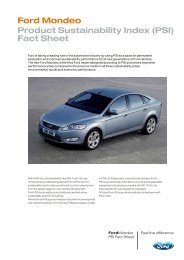Annual Report 2011 - Ford Motor Company
Annual Report 2011 - Ford Motor Company
Annual Report 2011 - Ford Motor Company
Create successful ePaper yourself
Turn your PDF publications into a flip-book with our unique Google optimized e-Paper software.
Notes to the Financial Statements<br />
NOTE 25. DERIVATIVE FINANCIAL INSTRUMENTS AND HEDGING ACTIVITIES<br />
In the normal course of business, our operations are exposed to global market risks, including the effect of changes in<br />
foreign currency exchange rates, certain commodity prices, and interest rates. To manage these risks, we enter into<br />
various derivatives contracts:<br />
• Foreign currency exchange contracts, including forwards and options, that are used to manage foreign exchange<br />
exposure;<br />
• Commodity contracts, including forwards and options, that are used to manage commodity price risk;<br />
• Interest rate contracts including swaps, caps, and floors that are used to manage the effects of interest rate<br />
fluctuations; and<br />
• Cross-currency interest rate swap contracts that are used to manage foreign currency and interest rate exposures<br />
on foreign-denominated debt.<br />
Our derivatives are over-the-counter customized derivative transactions and are not exchange-traded. We review our<br />
hedging program, derivative positions, and overall risk management strategy on a regular basis.<br />
Derivative Financial Instruments and Hedge Accounting. All derivatives are recognized on the balance sheet at fair<br />
value. We do not net our derivative position by counterparty for purposes of balance sheet presentation and disclosure.<br />
We do, however, consider our net position for determining fair value.<br />
We have elected to apply hedge accounting to certain derivatives. Derivatives that are designated in hedging<br />
relationships are evaluated for effectiveness using regression analysis at the time they are designated and throughout the<br />
hedge period. Cash flows and the profit impact associated with designated hedges are reported in the same category as<br />
the underlying hedged item.<br />
Some derivatives do not qualify for hedge accounting; for others, we elect not to apply hedge accounting.<br />
Regardless, we only enter into transactions that we believe will be highly effective at offsetting the underlying economic<br />
risk. We report changes in the fair value of derivatives not designated as hedging instruments through Automotive cost of<br />
sales, Automotive interest income and other non-operating income/(expense), net, or Financial Services other income/<br />
(loss), net depending on the sector and underlying exposure. Cash flows associated with non-designated or dedesignated<br />
derivatives are reported in Net cash (used in)/provided by investing activities in our statements of cash flows.<br />
Cash Flow Hedges. Our Automotive sector has designated certain forward contracts as cash flow hedges of<br />
forecasted transactions with exposure to foreign currency exchange risk.<br />
The effective portion of changes in the fair value of cash flow hedges is deferred in Accumulated other comprehensive<br />
income/(loss) and is recognized in Automotive cost of sales when the hedged item affects earnings. The ineffective<br />
portion is reported in Automotive cost of sales. Our policy is to de-designate cash flow hedges prior to the time forecasted<br />
transactions are recognized as assets or liabilities on the balance sheet and report subsequent changes in fair value<br />
through Automotive cost of sales. If it becomes probable that the originally-forecasted transaction will not occur, the<br />
related amount also is reclassified from Accumulated other comprehensive income/(loss) and recognized in earnings.<br />
Our cash flow hedges mature in two years or less.<br />
Fair Value Hedges. Our Financial Services sector uses derivatives to reduce the risk of changes in the fair value of<br />
liabilities. We have designated certain receive-fixed, pay-float interest rate swaps as fair value hedges of fixed-rate debt.<br />
The risk being hedged is the risk of changes in the fair value of the hedged debt attributable to changes in the benchmark<br />
interest rate. If the hedge relationship is deemed to be highly effective, we record the changes in the fair value of the<br />
hedged debt related to the risk being hedged in Financial Services debt with the offset in Financial Services other income/<br />
(loss), net. The change in fair value of the related derivative (excluding accrued interest) also is recorded in Financial<br />
Services other income/(loss), net. Hedge ineffectiveness, recorded directly in earnings, is the difference between the<br />
change in fair value of the derivative and the change in the value of the hedged debt that is attributable to the changes in<br />
the benchmark interest rate.<br />
<strong>Ford</strong> <strong>Motor</strong> <strong>Company</strong> | <strong>2011</strong> <strong>Annual</strong> <strong>Report</strong> 165


